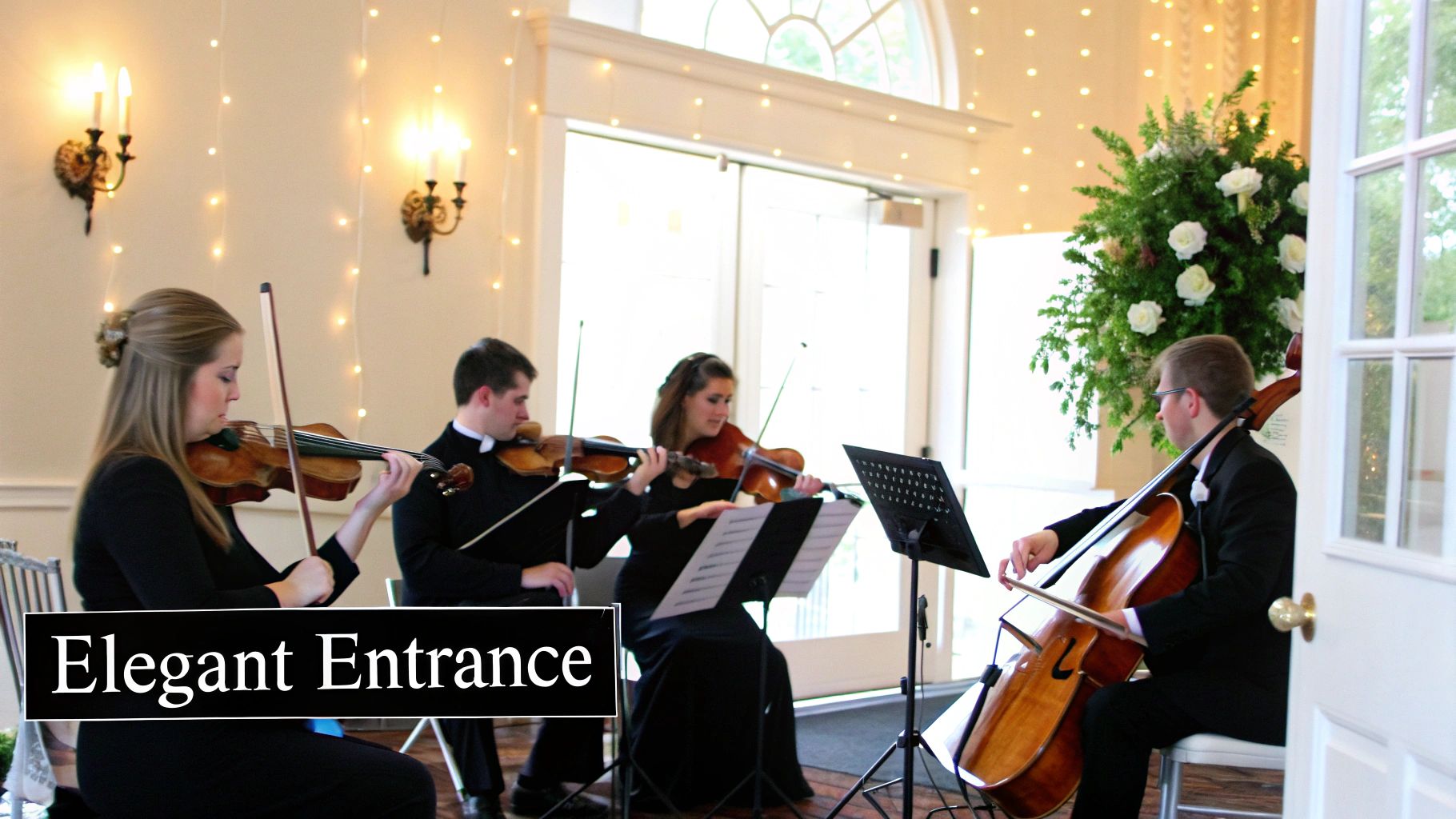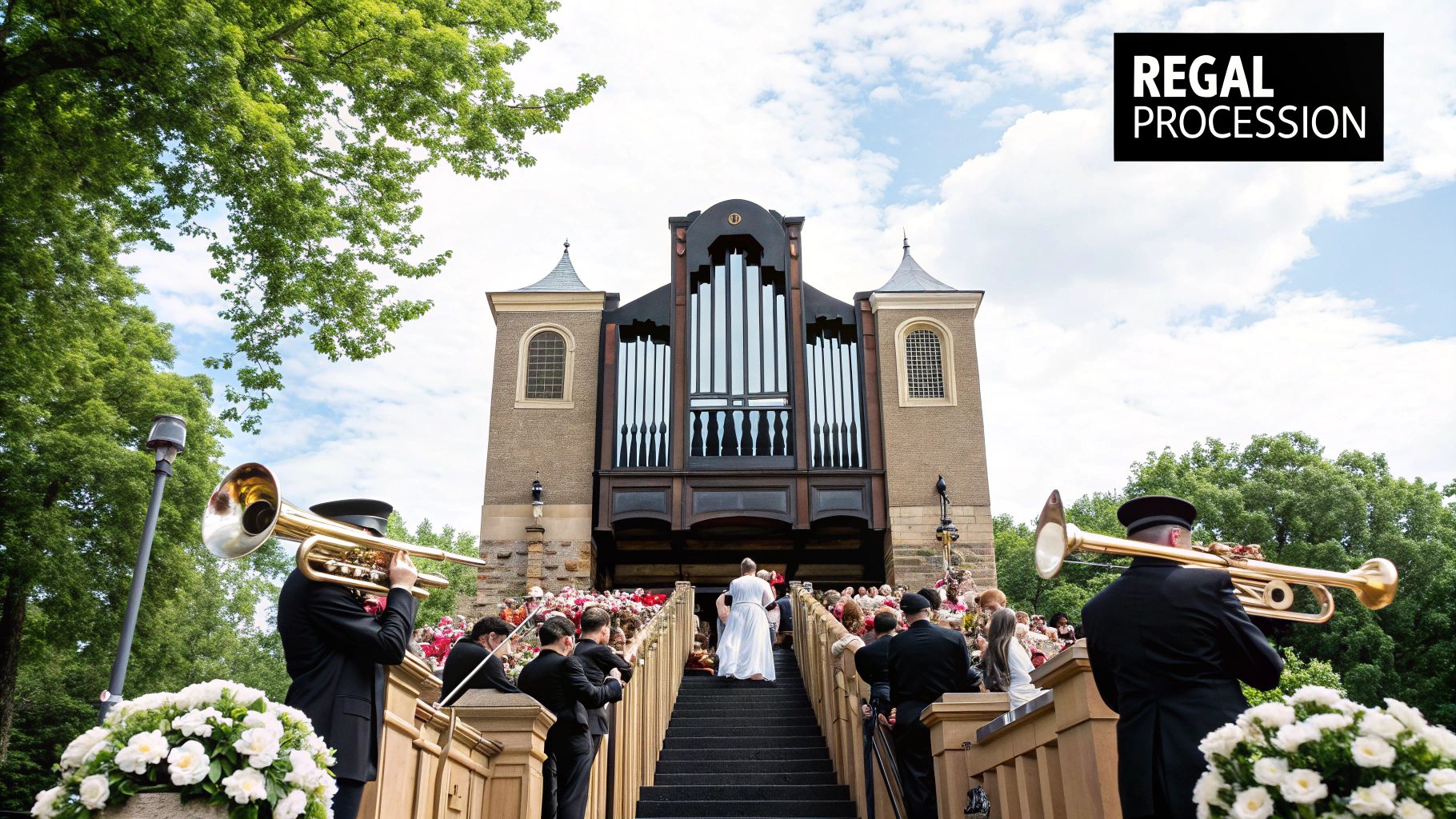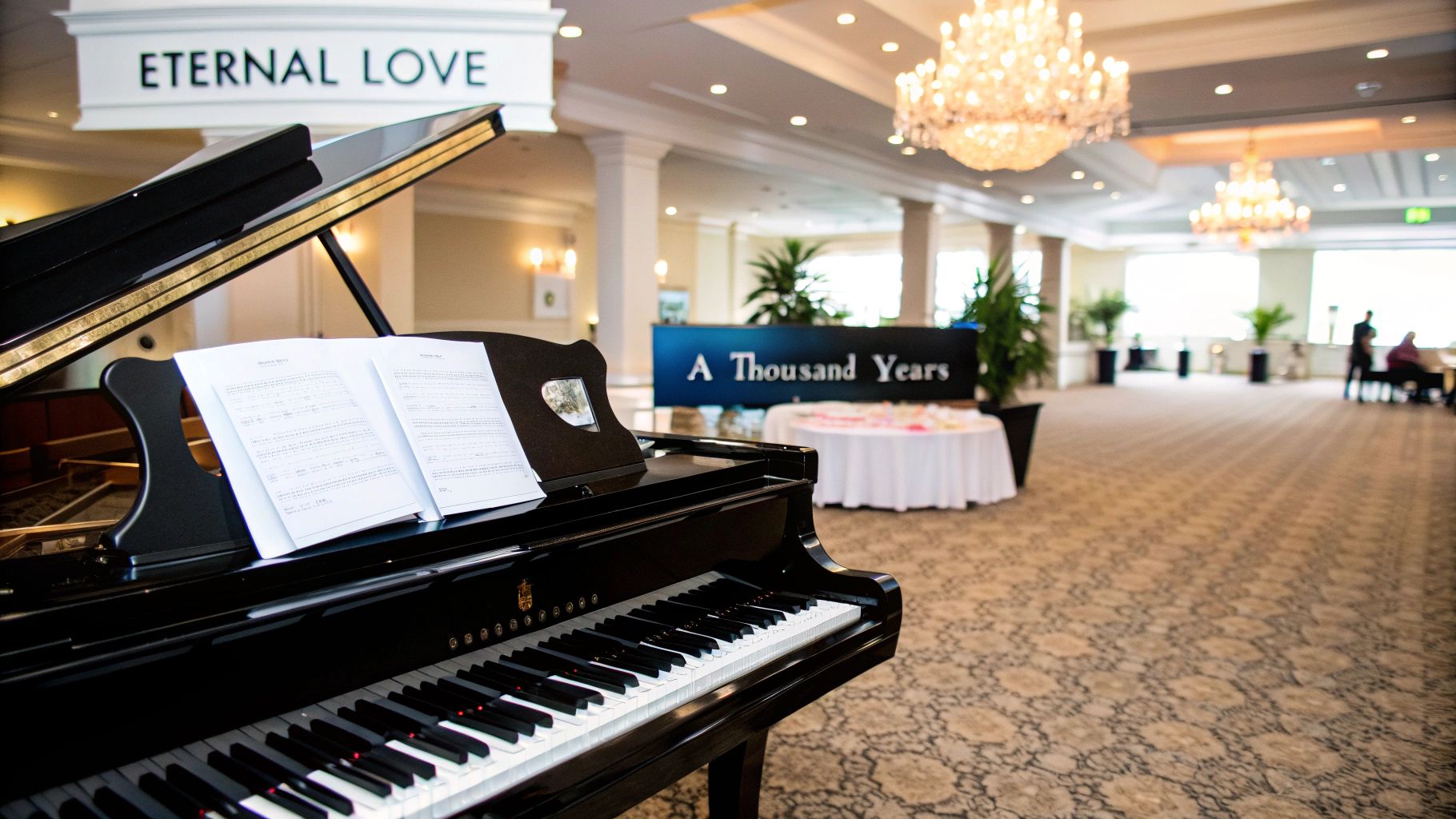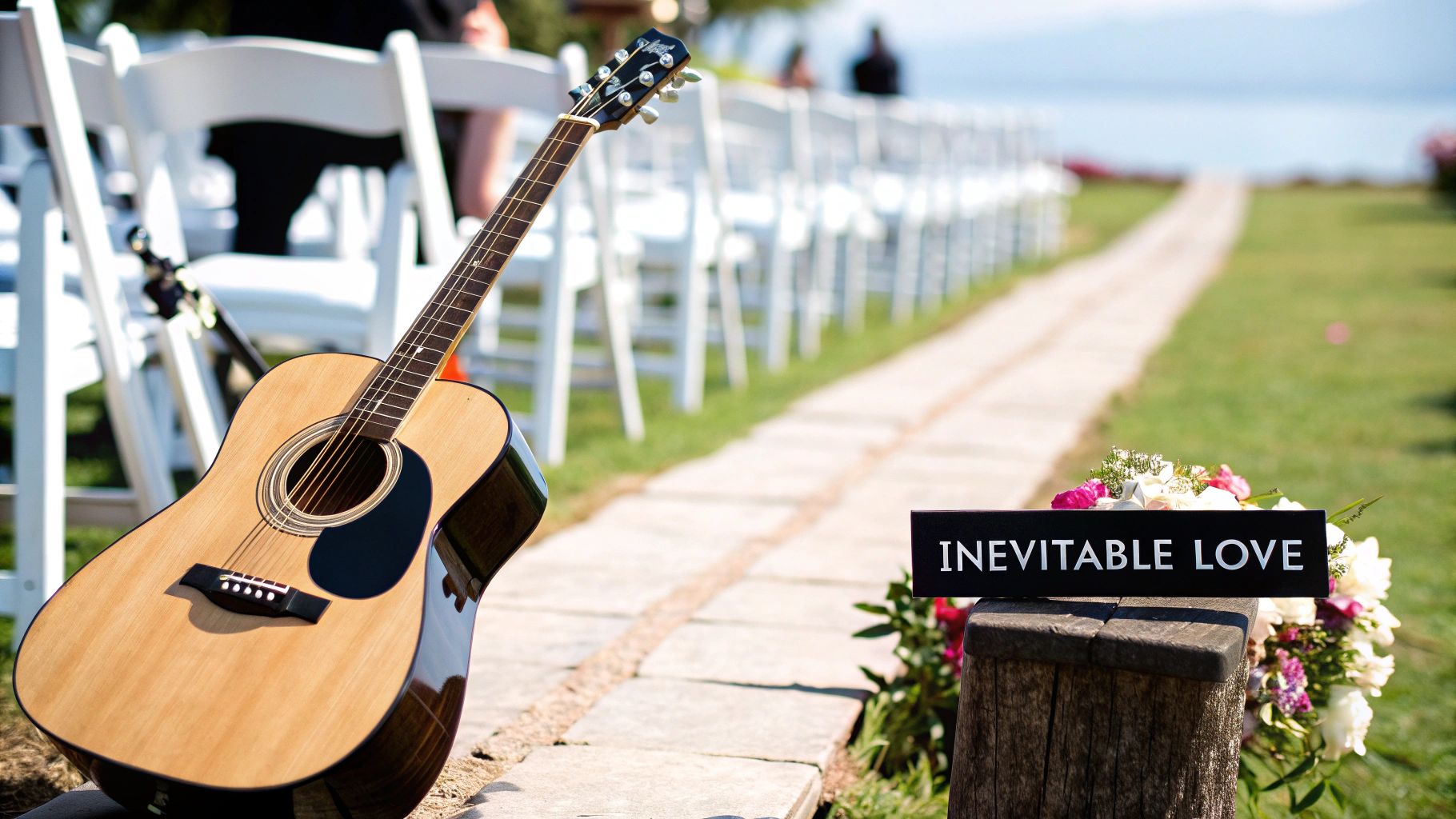Top 7 Best Wedding Processional Songs for Your Entrance
- Chase Gillmore
- May 2
- 15 min read
Setting the Tone: Choosing the Right Processional Music
Your wedding processional deserves the perfect soundtrack. This list of the best wedding processional songs offers classic and contemporary options to create the ideal atmosphere as you walk down the aisle. Discover seven stunning choices, from Pachelbel's Canon in D to Christina Perri's A Thousand Years, to find the music that makes your entrance unforgettable. The right processional music sets the emotional tone for your entire ceremony, whether traditional, romantic, or modern. For a live performance of these and other wedding classics, consider Texas wedding band Uptown Drive.
1. Canon in D by Johann Pachelbel
When discussing the best wedding processional songs, Canon in D by Johann Pachelbel consistently tops the list. This classical masterpiece, composed in the late 17th century, has transcended time to become a staple in wedding ceremonies worldwide. Its enduring popularity stems from its ability to evoke a sense of timeless elegance and profound emotion, perfectly capturing the gravity and beauty of the wedding procession. The piece's structure, a repeating bass line interwoven with increasingly complex melodies in the upper voices, creates a gradual crescendo that builds anticipation and signifies the bride's approach.

Canon in D's three-part harmony structure and gradual build in complexity contribute to its captivating effect. Typically lasting 5-6 minutes in its entirety, it provides ample time for the bridal party to proceed down the aisle, though shortened versions are frequently used. As a Baroque period composition, it offers a classic, sophisticated atmosphere. Its inherent walking rhythm makes it naturally suited to processional use.
Features:
Three-part harmony structure
Gradual build in complexity
Approximately 5-6 minutes in length (often shortened)
Baroque period classical composition
Pros:
Universally recognized and appreciated
Creates an elegant, timeless atmosphere
Can be performed by various instrumental combinations (string quartet, piano, guitar, etc.)
Has a natural walking rhythm suitable for processionals
Cons:
Very commonly used, potentially lacking uniqueness
Original version may be too long for some ceremonies
Can be challenging for amateur musicians to perform well
Some musicians find it repetitive to play
Examples:
Canon in D has graced countless high-profile weddings, including Chelsea Clinton's ceremony in 2010 and was used during Prince Harry and Meghan Markle's wedding as guests were being seated. These examples demonstrate its enduring appeal and suitability for grand occasions.
Tips for Implementation:
Traditional Ceremony: Consider a string quartet version for a classic, elegant feel.
Modern Twist: A piano and guitar duet arrangement can offer a fresh perspective.
Timing: Carefully time the processional with the music's natural crescendo to maximize impact.
Shortening: Discuss with your musicians precisely which section of the piece to use if shortening is necessary.
Popularized By:
Canon in D's reach extends beyond the concert hall. Its inclusion in films like "Ordinary People" and "The Hangover" and performances by renowned classical artists such as the Academy of St. Martin in the Fields have contributed to its widespread recognition.
Canon in D deserves its place among the best wedding processional songs because of its timeless beauty, emotional resonance, and adaptability. While its popularity might deter some seeking a unique choice, its undeniable elegance and powerful impact make it a perennial favorite for creating a memorable wedding procession. Whether you opt for a traditional string quartet rendition or a more contemporary arrangement, Canon in D offers a guaranteed touch of class and sophistication to your special day.
2. Wedding March by Felix Mendelssohn
When discussing the best wedding processional songs, Felix Mendelssohn's "Wedding March" remains a timeless classic. While traditionally used as a recessional (the exit of the married couple), its grandeur and triumphant feel have made it an increasingly popular choice for the bride's processional entrance as well. This iconic piece secures its spot on the list of best wedding processional songs due to its instantly recognizable melody and the dramatic, joyful atmosphere it creates.
Originally composed as part of the incidental music for Shakespeare's A Midsummer Night's Dream, the "Wedding March" wasn't associated with weddings until it was played at the marriage of Princess Victoria, Queen Victoria's daughter, and Prince Frederick William of Prussia in 1858. This royal endorsement cemented its place in wedding history, and it has been a staple ever since.
This bold, triumphant piece, composed in C major, is characterized by its distinctive fanfare-like opening and full orchestral composition. While often adapted for smaller ensembles, the original version is approximately five minutes long. Its powerful sound commands attention, making it ideal for the bride's grand entrance.
Features:
Bold, triumphant C major composition
Distinctive fanfare-like opening
Full orchestral composition (though often adapted)
Approximately 5 minutes in original form
Pros:
Instantly recognizable 'wedding music'
Creates a dramatic, joyful atmosphere
Commands attention for the bride's entrance
Works well in large venues where acoustics may be challenging
Cons:
Can feel overly conventional or cliché
Often associated more with recessionals than processionals
May overwhelm in very small, intimate venues
Religious connotations may not suit secular ceremonies
Examples:
Used in Prince William and Kate Middleton's wedding in 2011
Featured in countless royal and celebrity weddings historically, including the wedding scene in The Sound of Music
Tips for using the "Wedding March" as a processional song:
Timing: Consider starting from a specific point in the composition to perfectly time the bride's arrival at the altar.
Quality: Opt for professional musicians or a high-quality recording for the best impact.
Style: Pairs well with formal, traditional ceremonies.
Modernization: Consider contemporary instrumental arrangements for a fresh take on the classic.
Why choose the "Wedding March" for your processional?
If you envision a grand, traditional entrance and want a piece of music that instantly signals "wedding," the "Wedding March" is a strong contender. Its powerful melody and historical significance contribute to a memorable and emotional experience. However, consider the potential drawbacks, such as its traditional association with the recessional and its potential to feel overwhelming in smaller venues. Weighing these pros and cons will help determine if this iconic piece is the right choice for your best wedding processional songs.
3. Air on the G String by Johann Sebastian Bach
For couples seeking a wedding processional song that exudes timeless elegance and refined sophistication, Johann Sebastian Bach's "Air on the G String" is a truly exquisite choice. This piece, among the best wedding processional songs available, offers a depth of emotion and a serene beauty that sets a uniquely elegant tone for the ceremony. While it's technically the second movement of Bach's Orchestral Suite No. 3 in D major, its popular name comes from an arrangement by August Wilhelmj, adapted to be played solely on the G string of the violin. This arrangement lends the piece its characteristically rich and resonant sound.
This piece works by weaving a slow, graceful melody over a rich harmonic structure. Originally composed for a string orchestra, "Air on the G String" creates a truly captivating auditory experience, clocking in at approximately five minutes. Its slow tempo allows ample time for the wedding party to proceed gracefully down the aisle, and its emotional resonance adds a touch of solemnity and reverence to the occasion.
Features:
Slow, graceful tempo
Rich harmonic structure
Originally composed for string orchestra
Approximately 5 minutes in length
Pros:
Creates a sophisticated, elegant atmosphere
Less overused than some classical wedding standards
Suitable for religious and secular ceremonies alike
Emotional without being overwhelming
Cons:
May be too subdued for very large venues
Less instantly recognizable to general audiences
Requires skilled musicians to capture its nuance
May feel too somber for very celebratory wedding styles
Examples of Successful Implementation:
"Air on the G String" has been featured in numerous luxury brand advertisements, lending its aura of sophistication to various products and campaigns. It has also graced several high-profile weddings, including ceremonies of European aristocracy, further solidifying its association with elegance and refinement.
Tips for Implementation:
Perfect for the entrance of parents or wedding party members: The stately tempo and emotional depth are ideal for setting the stage for the bridal entrance.
Pairs beautifully with string quartet or solo violin/piano arrangements: These instrumental combinations enhance the inherent beauty of the piece.
Consider timing bridesmaids' entrances with the musical phrases: This creates a visually and aurally pleasing procession.
Works particularly well for outdoor garden ceremonies: The serene quality of the music complements the natural beauty of an outdoor setting.
Popularized By:
Famous recordings by violinists such as Jascha Heifetz have contributed to the enduring popularity of "Air on the G String." Its inclusion in films like "Se7en" (albeit in a dramatically different context) and various luxury brand advertisements has also brought it to a wider audience.
"Air on the G String" deserves its place on the list of best wedding processional songs because it offers a unique blend of elegance, sophistication, and emotional depth. While other classical pieces may be more instantly recognizable, this piece offers a refreshing alternative for couples seeking a less conventional yet undeniably beautiful option. Its timeless quality ensures that it will remain a cherished memory long after the wedding day.
4. Trumpet Voluntary by Jeremiah Clarke
For a truly grand entrance, consider Jeremiah Clarke's Trumpet Voluntary, a piece frequently chosen as one of the best wedding processional songs. Often misattributed to Henry Purcell, this baroque masterpiece, properly titled "Prince of Denmark's March," evokes a sense of regal majesty. Its triumphant trumpet fanfares, interwoven with stately organ accompaniment, create a powerful and ceremonial atmosphere ideal for elegant wedding processions, especially in grand venues like cathedrals. The piece's inherent drama and celebratory tone make it a fitting soundtrack for the beginning of a couple's journey together.

This composition, typically around three minutes in length in a standard performance, offers a compelling blend of bold, ceremonial trumpet fanfares and a stately tempo perfectly suited for a processional. Originally scored for trumpet and organ, it lends itself beautifully to the acoustics of churches with pipe organs. The structure of the piece also provides natural pauses, allowing for well-timed entrances of different members of the wedding party. As a bonus, it offers a refreshing alternative to more commonly used processional music like Canon in D or the Wedding March.
Pros:
Creates a regal, ceremonial atmosphere.
Perfect for church weddings with pipe organs.
Has natural pauses for timing different party members' entrances.
Less overused than Canon in D or Wedding March.
Cons:
Can feel overly formal for casual weddings.
Difficult to adapt for very small instrumental groups.
Traditional arrangement requires specific instruments (trumpet/organ).
May overwhelm in very intimate settings.
Examples of Successful Implementation:
The Trumpet Voluntary’s association with royalty solidifies its prestigious reputation. It was notably used in the wedding of Princess Diana and Prince Charles in 1981 and has been featured in period dramas depicting royal or aristocratic weddings, including the popular Netflix series "The Crown." These examples highlight its enduring appeal and suitability for grand occasions.
Tips for Implementation:
Venue: This piece truly shines in venues with excellent acoustics, especially churches where the resonance of the organ and trumpet can be fully appreciated.
Processional Timing: Consider having the wedding party enter during the quieter sections, reserving the more prominent trumpet fanfares for the bride's grand entrance.
Dynamics: Work closely with your musicians to adjust the dynamics to suit the size and acoustics of your venue, ensuring the music enhances rather than overwhelms the ceremony.
Length: If needed, the piece can be effectively shortened without losing its impact. Discuss this with your musicians beforehand.
Popularized By:
Royal ceremonies throughout history, acclaimed classical trumpeters like Alison Balsom, and numerous films depicting royal or aristocratic weddings have all contributed to the enduring popularity of the Trumpet Voluntary.
This piece earns its place among the best wedding processional songs because of its unique blend of grandeur, tradition, and timeless appeal. Its ability to elevate a wedding ceremony to a truly memorable event makes it a worthwhile choice for couples seeking a majestic and unforgettable entrance.
5. A Thousand Years by Christina Perri
For couples seeking a contemporary touch in their wedding processional, Christina Perri's "A Thousand Years" offers a blend of modern romance and timeless appeal. Released in 2011 as part of The Twilight Saga: Breaking Dawn soundtrack, this ballad swiftly ascended the ranks of popular wedding songs. Its lyrics, centered on enduring love and commitment, resonate deeply with the sentiment of a wedding ceremony. The gentle, waltz-like 3/4 time signature creates a natural walking pace for the bridal party, while the song's gradually building emotional intensity adds a touch of drama and anticipation.

"A Thousand Years" deserves its place among the best wedding processional songs due to its potent combination of lyrical relevance, emotional resonance, and adaptability. The lyrics speak directly to the vows exchanged during the ceremony, making it a particularly poignant choice for couples who connect with its message of everlasting love. The song's popularity, fueled in part by its inclusion in The Twilight Saga and subsequent viral wedding videos, speaks to its broad appeal, especially among younger generations. While the original version clocks in at approximately 4:45 minutes, it is available in various instrumental versions and arrangements, allowing for flexibility in timing and customization to suit different ceremony styles. Actress Kate Bosworth even chose this song for her 2013 wedding processional, further solidifying its place in wedding music history.
Features: Contemporary pop ballad in 3/4 time, building emotional intensity, meaningful lyrics about enduring love, approximately 4:45 minutes in original version.
Pros:
Lyrics directly relevant to wedding vows and commitment.
Appeals to younger couples seeking contemporary music for their best wedding processional songs.
Available in instrumental versions for traditional ceremonies.
Natural walking rhythm in its tempo.
Cons:
May feel dated to future generations due to its Twilight association.
Can be challenging to time perfectly without editing.
Original recording has modern production elements that may clash with very formal or religious settings.
Tips for Implementation:
Consider the piano instrumental version: For a more timeless and versatile feel, opt for a piano rendition. This allows the melody and emotion to shine without the potential distraction of the original’s pop production.
String quartet arrangements work beautifully: In formal settings, a string quartet arrangement adds elegance and sophistication.
Time the chorus to coincide with the bride's entrance: This creates maximum emotional impact as the bride makes her grand entrance.
Custom loops for perfect timing: If timing is a concern, ask your musicians to create a custom loop of certain sections to ensure a seamless transition.
Popularized By: Christina Perri, The Twilight Saga film series, viral YouTube wedding videos, and wedding pianists like Paul Hankinson who created popular instrumental arrangements. This widespread use demonstrates its enduring appeal as one of the best wedding processional songs.
6. Can't Help Falling in Love by Elvis Presley
Originally recorded by Elvis Presley in 1961, "Can't Help Falling in Love" is a timeless ballad that continues to be a popular choice among the best wedding processional songs. Its simple yet profound message of inevitable love, combined with a gentle, flowing melody, creates a romantic atmosphere perfect for wedding processionals, especially for intimate or more relaxed ceremonies. This classic tune offers a touch of nostalgia and heartfelt emotion as you walk down the aisle.

This song's enduring popularity stems from its versatility and emotional resonance. The slow waltz rhythm in 3/4 time provides a graceful and elegant feel, while the simple, memorable melody is instantly recognizable across generations. Clocking in at approximately three minutes, its shorter length makes timing the processional entrance easier. The heartfelt lyrics about surrendering to love resonate deeply, creating a beautiful emotional backdrop without being overwhelming. This makes "Can't Help Falling in Love" a strong contender among the best wedding processional songs.
Features:
Slow waltz rhythm in 3/4 time
Simple, memorable melody
Heartfelt lyrics about inevitable love
Approximately 3 minutes in length
Pros:
Recognizable across multiple generations
Adaptable to various musical styles, from classical to acoustic
Shorter length simplifies timing
Emotionally resonant without being overpowering
Cons:
May feel too casual for very formal ceremonies
Its ubiquity in films and commercials might create unwanted associations for some
The original recording might sound dated to some ears
Religious references ("take my hand, take my whole life too") may not suit all couples
Examples:
"Can't Help Falling in Love" has graced numerous celebrity weddings, including Priyanka Chopra and Nick Jonas's, and has been featured in both traditional church ceremonies and destination beach weddings, proving its adaptability.
Tips for Implementation:
Elevate the formality: String quartet versions add a touch of elegance for formal ceremonies.
A fresh perspective: Consider a female vocalist version, like Haley Reinhart's popular cover, for a contemporary twist.
Embrace the outdoors: Acoustic guitar accompaniment creates a magical ambiance for outdoor ceremonies.
Perfect timing: Time the entrance to coincide with the lyric "Take my hand, take my whole life too" for a truly impactful moment.
Popularized By:
Elvis Presley's original recording, UB40's 1993 reggae cover, its inclusion in films like "Blue Hawaii" and "Crazy Rich Asians," and Haley Reinhart's viral cover for an Extra gum commercial have all contributed to the song's lasting presence in popular culture.
"Can't Help Falling in Love" deserves its place among the best wedding processional songs because it offers a perfect blend of romance, timelessness, and adaptability. Its emotional depth, combined with its practical advantages, makes it an excellent choice for couples seeking a song that embodies the spirit of their love story as they embark on their journey together.
7. Ave Maria by Franz Schubert
For couples seeking a wedding processional song imbued with profound emotion and timeless beauty, Franz Schubert's "Ave Maria" remains a classic choice. This iconic piece, composed in 1825 as part of his Opus 52, blends spiritual devotion with breathtaking musicality, creating an atmosphere of reverence and blessing ideal for the solemnity of a wedding ceremony. Its inclusion in our list of best wedding processional songs stems from its enduring popularity and its ability to evoke deep emotion.
"Ave Maria" is characterized by its gentle, flowing melody and sacred Latin text, a prayer to the Virgin Mary. While traditionally sung, instrumental versions offer an equally powerful experience. Standard performances typically last 5-6 minutes, which, while lending grandeur, may require editing for processional timing.
Features and Benefits:
Gentle, flowing melody: Creates a serene and peaceful atmosphere.
Sacred Latin text: Adds a layer of spiritual significance (though instrumental versions avoid specific religious references).
Versatile performance: Can be performed vocally or instrumentally, offering flexibility for different ceremonies.
Timeless appeal: Resonates with multiple generations, ensuring a classic and elegant feel.
Variety of arrangements: From solo performances (cello solos are particularly moving) to full orchestral renditions, allowing customization to fit the scale and style of the wedding.
Pros:
Creates a profound, sacred atmosphere.
Works especially well in traditional houses of worship.
Holds timeless appeal across generations.
Available in various arrangements, from solo to orchestral.
Cons:
Religious nature may not suit secular ceremonies.
Extended length might require editing for processional timing.
The full emotional impact often requires skilled performers.
May feel overly solemn for celebratory-focused weddings.
When and Why to Use "Ave Maria":
This piece works beautifully for traditional, religious ceremonies, particularly within grand church settings. Its evocative melody sets a tone of reverence and solemnity, perfectly complementing the significance of the marriage vows. However, its religious context should be considered, and couples planning secular ceremonies might opt for instrumental versions or different pieces altogether.
Examples of Successful Implementation:
"Ave Maria" has graced numerous high-profile weddings, including that of Prince Albert II of Monaco to Charlene Wittstock. It's a standard selection for Catholic and many Christian denomination weddings globally, further cementing its status as a timeless classic. Its use in films like "The Age of Innocence" and performances at celebrity weddings such as Catherine Zeta-Jones and Michael Douglas’s have also contributed to its enduring popularity.
Actionable Tips for Using "Ave Maria" in Your Wedding Processional:
Timing: Consider using "Ave Maria" for the seating of parents or as a musical interlude just before the bridal processional.
Instrumental Versions: Opt for instrumental arrangements if religious references aren't desired.
Cello Solos: Cello solo arrangements create a particularly moving and intimate atmosphere.
Medleys: Combine "Ave Maria" with other pieces in a medley format to adjust the overall timing.
Popularized By:
Iconic renditions by artists like Maria Callas, Luciano Pavarotti, and its inclusion in popular culture have firmly established "Ave Maria" as a powerful and emotionally resonant piece of music. This, combined with its inherent beauty and versatility, makes it a truly exceptional choice among the best wedding processional songs.
Top 7 Wedding Processional Songs Comparison
Song Title | Implementation Complexity 🔄 | Resource Requirements ⚡ | Expected Outcomes 📊 | Ideal Use Cases 💡 | Key Advantages ⭐ |
|---|---|---|---|---|---|
Canon in D by Johann Pachelbel | Moderate – requires skilled musicians for variations | Flexible – can be performed by various ensembles | Elegant, timeless atmosphere with emotional build | Traditional weddings; processional music | Universally recognized; natural rhythm for walking |
Wedding March by Felix Mendelssohn | High – full orchestral or professional recordings preferred | High – orchestral or high-quality adapted versions | Dramatic, triumphant, attention-commanding entrance | Large venues; formal ceremonies; recessional or processional | Instantly recognizable; grand and joyful |
Air on the G String by J.S. Bach | Moderate – requires nuanced, skilled players | Moderate – string quartet or solo instruments | Sophisticated, refined, emotionally deep atmosphere | Elegant, outdoor, or garden ceremonies | Less overused; emotional yet subtle |
Trumpet Voluntary by Jeremiah Clarke | Moderate – specific trumpet and organ instruments needed | Specific – trumpet and organ essential | Regal, ceremonial, majestic atmosphere | Grand venues, churches, formal settings | Natural pauses for timing; less common than Canon |
A Thousand Years by Christina Perri | Low to moderate – modern ballad, timing can be tricky | Flexible – solo piano, string quartet, or instrumental | Romantic, modern, emotionally intense | Contemporary weddings; younger couples | Lyrics relevant to vows; popular modern choice |
Can't Help Falling in Love by Elvis Presley | Low – simple arrangement and short length | Flexible – acoustic to classical ensembles | Romantic, intimate, emotionally tender | Intimate or relaxed weddings | Multi-generational appeal; easy to time |
Ave Maria by Franz Schubert | High – usually requires skilled vocalists or instrumentalists | Moderate to high – soloists or orchestras | Profound, sacred, solemn atmosphere | Religious weddings; solemn moments | Timeless spiritual appeal; versatile arrangements |
Creating Your Perfect Processional: Beyond the Music
Choosing the best wedding processional songs sets the tone for your entire ceremony. From timeless classics like Canon in D and the Wedding March to modern favorites like A Thousand Years and Can't Help Falling in Love, the perfect song can evoke a range of emotions, from joy and reverence to anticipation and love. We've explored some top choices, including Air on the G String, Trumpet Voluntary, and Ave Maria, each offering a unique character and style. However, selecting the right music is just the first step.
The most important takeaways are to consider the overall atmosphere you want to create and how your chosen processional song contributes to it. Think about the acoustics of your venue and how they might impact the music's resonance. Discuss your vision with your wedding planner and chosen musicians to ensure they understand your preferences and can execute them flawlessly. Seamless transitions between musical pieces are crucial for a polished and professional feel.
Mastering these concepts will not only result in a beautiful and memorable processional but also set the stage for a truly unforgettable wedding celebration. By carefully considering the musical landscape of your ceremony, you can ensure a cohesive and emotionally resonant experience for you and your guests. The right music can transform your wedding from a simple event into a powerful expression of your love story.
Ready to elevate your wedding ceremony with a stunning live performance that seamlessly incorporates your best wedding processional songs? Uptown Drive specializes in creating unforgettable musical experiences tailored to your unique vision. Visit Uptown Drive today to explore how they can bring the magic of live music to your special day.
Article created using [Outrank](https://outrank.so)
